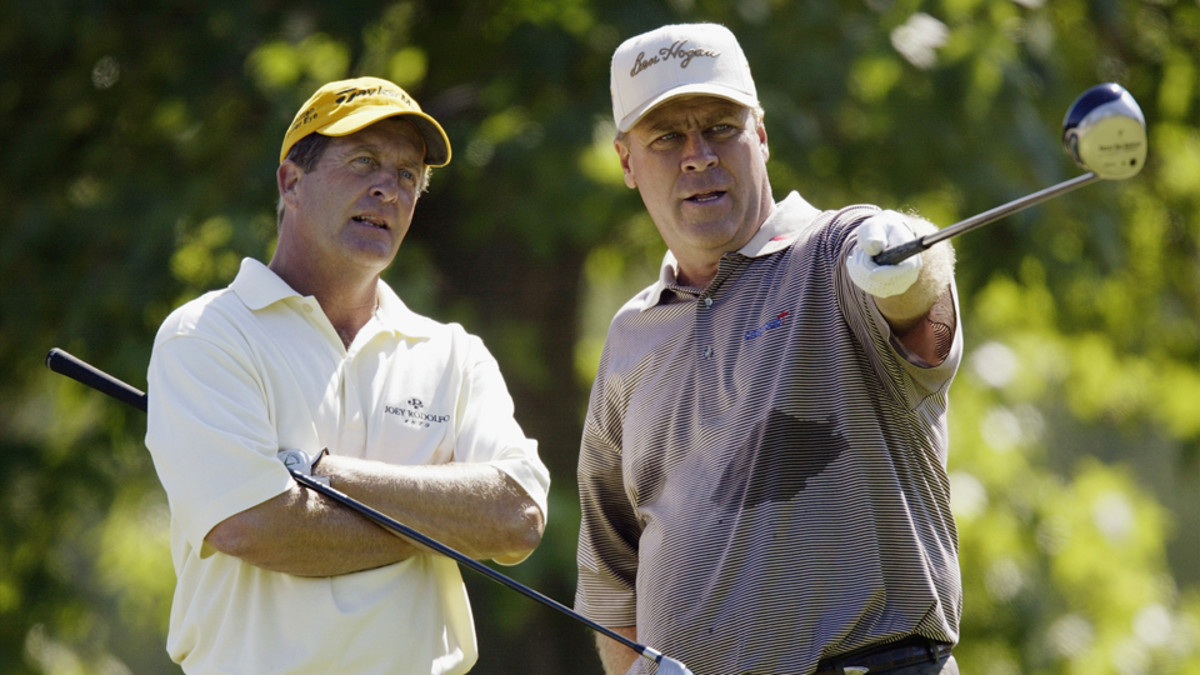Keeping Up With Tiger: Two PGA Legends Weigh in on Fitness in Golf
Golf is the game you’re supposed to be able to play forever, expertly swinging clubs into your eighties after your knees give out and your stamina drops to a two-minute walk. But the idea of golf as a game for old men has changed in the post-Tiger Woods era, or ever since the then-20-year-old came roaring into dominance with his muscular arms, 400-meter-sprinting speed and professed penchant for spending hours in the gym. Now, nearly all young golf pros have some sort of fitness regimen, while the best in the bunch, including Adam Scott, Rory McIlroy and Dustin Johnson, are known to train hard for a sport that, traditionally, hasn’t demanded much sweat equity from its practitioners. Is it time for older golfers to step up their game?
If you’re Hal Sutton, who famously beat Tiger Woods at the 2000 Players Championship when he was 41 and Woods was just 24 (and viewed at the time as unbeatable), the answer to that question is a resounding no. “Health and fitness are very important to the younger generations in the world,” says Sutton, now 56 and part of the Champions Tour. “But I believe in hitting balls and working on my golf swing—that’s what I believe in. And that’s what I spend my time doing.”
Sutton says he doesn’t think any player, young or old, needs to spend time in the gym to have a long and successful career like his, which includes 30-plus years on the PGA Tour and the 1983 PGA Championship title to boot. “I think the key to longevity is commitment: staying committed to doing what you do everyday,” Sutton says. “I think a lot of young people are committed—committed to their fitness and health. But the guys who stay a long time [in pro golf] are committed to staying in the game. Commitment is the foundation to whatever you do.”
While Sutton’s approach may be hard-edged—“I’m not your poster child for health and fitness, I’m your poster child for a lot of practice”—his take on training is hardly unusual on the Champions Tour, says veteran player Fred Funk. “Most guys don’t do squat,” says the 58-year-old pro of his contemporaries. “[Fitness] wasn’t part of their routine, and it isn’t now. Most guys just want to do whatever they do and swing a golf club.”

Fred Funk studies the ninth green during the second round of the Encompass Championship golf tournament in Glenview, Ill., Sunday, June 22, 2014.
AP Photo/Nam Y. Huh
But Funk, unlike Sutton, does believe fitness can help prolong a player’s talent—and time—on the links. “The guys who have really extended careers, well, some of them are in great shape,” says Funk, who in 2005 became the oldest player to win the Players Championship, at age 48. “Guys who have been playing pretty hard are usually doing something [in the gym], even if that’s not the majority.”
Funk says he has worked out his entire career and still hits the gym for cardio and weights several days a week. “The last 10 or 15 years, I’ve adopted more range-of-motion stuff,” says Funk, currently also on the PGA Tour, where he has played since 1989. “I’m doing more rotary type training where you’re doing a lot of twisting and turning—more golf-specific training, not heavy weights, but a lot of repetitions, a lot of stuff with pulleys, and I’m trying to stay flexible as much as I can. Especially as you get older, you lose muscle composition and range of motion, so you have to work harder maintain it.”
Will MacKenzie's Extreme Path to the PGA Tour
Funk says a fitness plan also helped him recover from a knee replacement in 2009 before he won the U.S. Senior Open. (Sutton also had two hips replaced—both players are sponsored by the orthopedic-device maker Stryker.)
“I think [physical fitness] has allowed me to play the game at a really high level still,” Funk says. “And if you look at past greats, Sam Snead was the pioneer of being strong. Arnold Palmer was as strong as an ox, and it was ridiculous how fit he was fit. And then Tiger [Woods] comes along and puts a whole new level of fitness and looks like a defensive back. And now these guys are training like crazy. Everybody’s trying to find that edge, and there’s such a fine line between success and failure, so if you can get an edge, you’re going to do it.”
In Sutton’s case, the edge he had when he bested Tiger Woods at the 2000 Players Championship may have been a desire to crush the doubters. “I led the tournament pretty much from start to finish, so it was a whole week of people telling me I couldn’t [win],” Sutton says. “Someone told me I was too old to win, but I think age is all in your mind. I didn’t feel like backing off, even though the media kept telling me to back off in their little ways. But I kept telling myself [Woods] is just another man who puts his pants on every morning like you do.”





